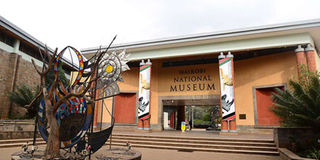Labour of love that led to the birth of Nairobi Museum

A photo of National Museum taken on August 29, 2019. On October 2005, the museum closed its doors to the public for the first major renovation since 1930. PHOTO | SALATON NJAU | NATION MEDIA GROUP
What you need to know:
- After Kenya attained independence, the Coryndon Museum was renamed the National Museum in 1964.
- It is home to notable exhibits such as the remains of Ahmed of Marsabit, the only elephant to be declared a monument in the country’s history.
It is arguably one of Nairobi’s most prominent landmarks with a history dating back more than a century.
Yet not much is known of the iconic building now known as the Nairobi National Museum.
Home to notable exhibits such as the remains of Ahmed of Marsabit, the only elephant to be declared a monument in the country’s history; the museum is as an educational and cultural institution that is a must-visit for tourists and locals alike.
A trove of artefacts and discovered items, the grand building was the product of a meeting held in March, 1909, at the home of Lieutenant Governor F.J. Jackson - an explorer, administrator, and ornithologist; to discuss the formation of a natural history society in East Africa, which became the East Africa and Uganda Natural History Society (EA & UNHS).
They were involved in collecting scientific specimens of natural history specimens.
NEW PLAN
A house was required to display the specimens, so one was built at the old Provincial Commissioner’s Office in Nairobi.
It opened its doors to the public in 1910, with Mr T.J. Anderson, a Briton, as its first curator.
But this was a temporary location since a bigger, more permanent structure was under construction on Kirk Road (Harry Thuku Road) in 1921. It was opened by Sir Edward Northey in 1922.
As the Museum grew, the society once again found itself needing more space. So after the First World War, the members established the Coryndon Memorial Fund, named after Sir Robert Coryndon who governed Kenya between 1922-1925.
The fund was for the construction of an extension to the Kirk Road Museum.
But the government had drawn up a new town plan, which called for the demolition of the existing building. So the society chose a new site on Ainsworth Hill (Museum Hill).
Thus the Coryndon Memorial Museum was built and was officially opened on September 1930 by Sir Edward Grigg, with Dr V.G.L. Someren as the honorary curator.
FUNDING
It was in this building that Dr Louis S.B. Leakey, who was excavating fossils in East Africa, was provided with storage and working space in the new study rooms for his collection of archaeological and paleontological specimens.
The fossils he and his wife Mary collected are now part of a fascinating exhibit at the Hominid Skull Room at the Museum.
During this period, there was a marked increase in the items collected - including bird, mammal, fish, insect, plans, ethnographical, palaeontological and geological specimens.
The museum also housed a library, whose collection was also fast increasing. Consequently, there was a need for more funding. The society relied heavily on donations from a board of volunteers.
A committee was established in 1930 following a request by the society that the relationship between the Coryndon Memorial Trust and the EA & UNHS be investigated, and the conditions under which the museum was maintained.
EXPANSION
The results led to the formation of a new board of trustees, and the appointment of a management committee for the museum was set up by the trustees in 1945. Following these deliberations, the society’s assets were transferred to the board of trustees, with the exception of the library. Mr Someren resigned in 1940 and was succeeded by Dr Leakey.
The current building, Coryndon Memorial Hall, continued to expand in subsequent years.
By 1945, it housed the herbarium, ornithology, entomology, mammalogy and ethnology sections.
Special fund kitties were set up to add more extensions, including five new halls, which were officially opened by Sir Evelyn Baring in 1953.
They included the Aga Khan Hall, built with donations from the Aga Khan, which became the Hall of Man.
Other halls included the Gandhi, built with funds donated by the Hindu community, a botanical hall with paintings exhibited by Joy Adamson and Churchill Hall.
RENAMING
After Kenya attained independence, the Coryndon Museum was renamed the National Museum in 1964.
It has since been renamed as the Nairobi National Museum, with further extensions made to the exhibition hall.
On October 2005, the museum closed its doors to the public for the first major renovation since 1930. It reopened on June 2008, complete with a restaurant and a shop.
Today, hundreds of visitors pass through its doors daily, yet few are aware of the collaborative efforts made to ensure it kept its doors open and stood the test of time.
Next time you pay a visit to the museum, appreciate the way it has developed over the years, and remember the saying, “Alone, we can do little; together we can do so much.”
Is there a site you want us to feature? Write an e-mail to [email protected]




